CTIA 2006
Apr 11, 2006, 12:08 AM by Rich Brome and Eric Lin
On-the-scene coverage of CTIA Wireless 2006. Exclusive photos and hot info from Las Vegas. New phones from HTC, Pantech, LG, Disney, Helio, Samsung, Nokia, Kyocera, and more.
Intro
The winter trade show season is almost over. As usual, the finale is CTIA Wireless. Although technically not as big as CES or 3GSM, CTIA focuses on the Americas market, making it a more important show for those of us in the U.S..
While most companies have already unveiled their GSM lineups for the coming months, CTIA is typically where we finally get to see what's in store for the CDMA carriers this year. This year is no different than past years; while many new CDMA phones are being announced, the number of significant new GSM phones can probably be counted on one hand.
MVNO news is also big this year. While the MVNO space is already quite crowded, two brand-new MVNOs made a splash at opposite ends of the age spectrum: Disney Mobile for kids, and Jitterbug for the grandparent market.
In general, most companies have shifted away from announcing whole-year lineups all at once like they used to. Most of the phones announced at the show this year are only the ones that will launch in the next 3-4 months. Most companies are keeping their 2nd-half lineups under wraps until later for competitive reasons. Unfortunately that means a few less new phones than past shows, but less waiting for the phones that are being shown to hit the market.
Part 1
LG
LG showed off something for everyone. Our Korean friends showed off something for everyone - new handsets for Cingular, Sprint and Verizon.
LG's phones for CDMA carriers are looking better and better, but they're still behind when it comes to GSM. Not technologically - the CU320 is one of the first 3G phones be launched on Cingular - but certainly style-wise. The LG225 is an entry level cameraphone that will replace the C2000. Like its predecessor, it is small and feels good in the hand, but is otherwise unremarkable. It is one of the few entry level phones announced at CTIA that did not add Bluetooth, which comes as a bit of a surprise.
Another phone that simply replaces the model before is the VX5300. Like the Cingular phone, the 5300 gets a smoother, sleeker makeover but it also adds Bluetooth to the feature set of its predecessor.
At the opposite end of the spectrum both in style and features is the LG550. This well-sized, good looking phone is packed with features. Although it may not top out Sprint's PowerVision lineup, the 550 will certainly be at the high end of things when it launches, and hard to resist as well. The phone will come with 3 faceplates for the front, which also features a large music control panel in addition to the external color display. Inside is a large screen, and great keypad. The keypad is nearly flush with the phone but is made out of a textured translucent rubber. The face around the phone is shiny and smooth. This difference in textures makes the keys easy to find by feel. The keypad gently glows when lit up and just oozes style.
In addition to looking good, the 550 is packed with features. It has a MicroSD slot, EV-DO and all the features that comes along with Sprint's EV-DO lineup - music player, streaming video, etc. The 550 also has some additional unique features. It will feature the same type of customizable interface as the Sanyo MM7500. It has an FM transmitter to play your music through nearby radios, and it has a ringtone composer that allows you to hum a tune, then apply a musical instrument to that melody and save it as your ringer. Oddly, the Bluetooth is not stereo, and the headset jack is 2.5mm instead of 3.5mm headphone jack, but the very handy FM transmitter may make up for those shortcomings.
Although it is a different color, and slightly thinner, the 8300 can not shake its similarity to the VX8100. Other than the physical change, the only obvious new features of the 8300 are the move from MiniSD to MicroSD, and the addition of stereo Bluetooth.*
That is until you start looking through the phone's menus. Verizon wasn't publicizing it, but LG let us know the 8300 is the first announced phone that will use Verizon's new Flash-based UI. The home screen and main menus are skinnable with a variety of options. Beyond the main menus, different color themes are applied to the applications and sub menus to match the theme.
We also have a video of the differnet menu themes so you can see both how they look and how each is animated:
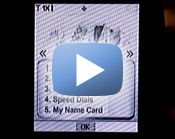
QuickTime format
* Updated April 6 to add mention of stereo Bluetooth.
Nokia
Nokia's new phones for CTIA are pretty much what one might expect. The emphasis is on CDMA, and like many manufacturers this year, Bluetooth is being added to most mid-range and even entry-level phones.
The 6175 is a mid-range clamshell phone, and the highest-end of the three new CDMA models.
The 6175 is a very stylish phone, with a good solid feel in hand. The internal antenna contributes to the sleek profile, although - as with some past models - carriers have required Nokia to add an extendable whip antenna for maximum reception ability.
Since this is a mid-range phone, there's no EVDO high-speed data or memory card slot. However it does sport a few higher-end features like Bluetooth 2.0 with stereo audio and EDR (Enhanced Data Rate) support. There's also a 1.3 megapixel camera with LED flash, stereo FM radio, and speakerphone.
Moving down the line...
...we have the 2865, a bar-style phone that could almost be considered an upgrade to the 6235 and 6236. Upgrades over that model include a larger display, Bluetooth 2.0, and over-the-network sync of calendar and contact info (like SyncML). However the 2865 does not have the camera that the 6235 and 6236 do, so it's not entirely a fair comparison.*
Like the 6175, the 2865 is sleek and light, yet has a solid feel to it with good ergonomics.
The lowest-end phone of the three is the 2365:
This small and light clamshell model is designed to bring Bluetooth (version 2.0, no less) to a new low price point for CDMA. Other than Bluetooth and FM radio, the features are pretty basic.
The style of the 2365 didn't really appeal to either of us, and it has a cheap feel to it. Not helping the situation is the chrome on the front, which attracts (very visible) fingerprints like nobody's business.
On the GSM side, the only "new" phone was the 6126, which is almost exactly like the 6131 announced at 3GSM last month. The only difference is the 6126 lacks infrared and FM radio, since those features are much less popular here than in Europe.
The 6126 / 6131 (and 6133) is definitely a nice phone. The displays are great, the form factor is near-perfect, and the feature list is extensive. Nokia expects it to be a huge seller worldwide, and we expect the same.
Kyocera
Kyocera's new phones at CTIA consist of three CDMA clamshell phones. What's new with these models are internal antennas. Like other manufacturers, Kyocera is also adding Bluetooth to more of its phones.
The flagship of this little series is the K822. Although it doesn't have EVDO high-speed data, it has just about every other feature one might want in an upper-mid-range phone. Highlights include a 1.3 megapixel camera, microSD memory card slot, and a great-looking 176 x 220 TFT main display. It also has advanced voice functions, including text-to-speech for listening to text messages.
However it's the music features that are especially advanced for a non-EVDO phone. They include stereo Bluetooth, FM radio, external media controls, and support for most major music formats, including Windows Media DRM files.
On the entry-level side is the K320 series, which includes the K322 and K323. The differences within the series are only styling, with the K322 sporting a vertical outer display and an oval d-pad, while the K323 has a horizontal outer display and more angular keypad design.
The K320 series replaces the Candid KX16. Most features are similar, including a VGA camera, STN main display, speakerphone, and voice dialing. Upgrades over the Candid primarily include a larger main display and an internal antenna. Carriers can also opt to offer Push-To-Talk and/or Bluetooth with phones this series.
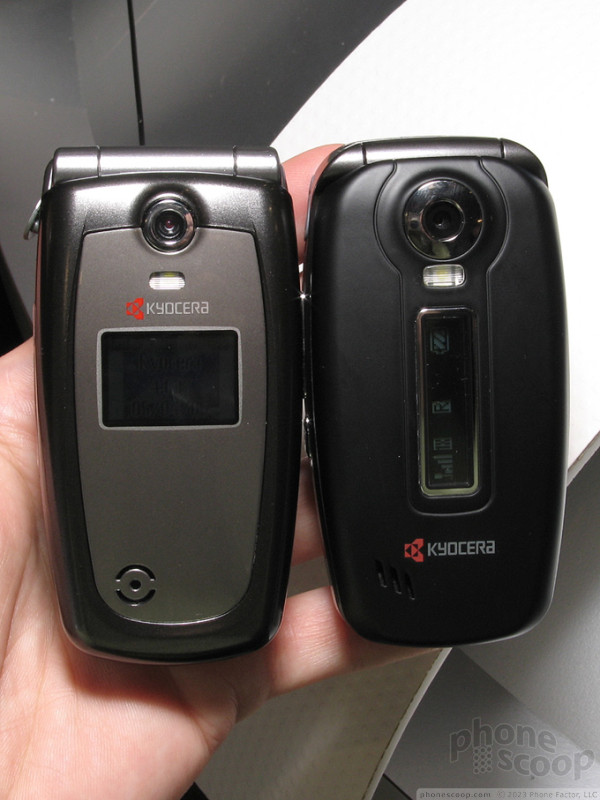
The K340 series - which for now consists only of the K342 - is based on the same design as the K320, but steps up to a color outer display, a 1.3 megapixel camera, and a TFT display. Bluetooth is also standard on this series. The inside of the K342 is indistinguishable from the K323. *
Kyocera was also demonstrating a MediaFLO phone. MediaFLO is one of the new live-TV technologies being hyped this year. Its main competitor here in the States is DVB-H. Both are digital multi-cast technologies that operate in dedicated radio spectrum. MediaFLO operates in the 700 MHz band that used to be UHF TV channel 55. MediaFLO is backed by Qualcomm and Verizon has announced plans to launch it.
The Kyocera MediaFLO phone is an extremely slim and sleek clamshell phone with a huge 2.4-inch OLED main display. Although it bears resemblance to Kyocera's Japanese phones, this is a unique model that Kyocera may bring to the US. It's a very early prototype and there's no name for it yet, but with some luck we'll see it down the road.
The OLED display is interesting. While the first OLED prototypes several years ago blew the doors off any LCD at the time, in recent years TFT LCDs have improved in quality and dropped in price. That part of the reason companies like Sanyo have recently given up on OLED technology. Kyocera is still hard at work on it though, and hopes to commercialize it by the end of this year.
The Kyocera OLED display on the MediaFLO phone looked great, although it was hard to tell if it looked much better than a good TFT LCD display. The viewing angle was better, as expected, but for normal direct viewing, it's hard to tell. I wouldn't have known it was an OLED if I hadn't been told. That's not a bad thing; I'm just not sure how one is supposed to compare two display types that both fall into the "really great-looking" category. I suppose it's a nice problem to have.
Unfortunately the status of MediaFLO is currently in limbo due a dispute with the FCC over potential interference issues. It's possible the FCC will rule against Qualcomm, preventing the MediaFLO network from launching by the end of the year as planned.
* Updated April 7 to correct display spec.
Part 2
Helio
There was so much tp talk to Helio about, we kept several of their people busy long past our allotted time, and held a another captive for an extra half hour while we took pictures and had him give us a video tour of the Helio phone software and interface. Helio actually hired the designers of the Hiptop interface to create their UI, and he has made sure that every screen of their phones is both good-looking and easy to use.
(The photos below are from an early version of the software. Scroll down to the video for the full experience.)
Helio will launch its first two phones - the Kickflip and Hero - this Spring, and will add two, or possibly three more to the lineup by year's end.
When Helio launches they won't just sell the phones online like many of the recent MVNOs, instead they will launch pop-up stores at high end youth boutiques around the country, such as Huf in San Francisco. When you stop in to buy a pair of fresh kicks, you'll be able to play with the phones and even take one home with you.
The Kickflip and Hero share most their features - 2 megapixel cameras, MicroSD card slots, QVGA screens and media player. Despite the hip, tech-savvy crowd Helio hopes to attract, neither of their first two phones offer Bluetooth.
Even though they share many features, the phones are different. The Hero is the powerhouse. It adds a graphics co-processor for faster video and better gameplay.
It is the larger and heavier of the two and looks a bit Borg-like. There are silver buttons and speaker grills sticking out of the black body at various odd angles. None of these bits and bobs stick out enough to make the Hero uncomfortable to use or hold, but they certainly don't give it the same clean look as the Kickflip. Like any good slider, there are navigation keys on the face and a keypad with hexagonal keys below - further enhancing the Borg-like appearance.
The Kickflip is physically the opposite of the Hero. It is white and smooth. Although Helio describes the finish as "pearlescent", the effect is very subtle and not nearly as feminine as it might sound.
There are no controls on the face of the Kickflip, which swivels in either direction to open. The spring-assisted spinner mechanism has an addictive quality. The Kickflip is also just plain sexy. The nifty swivel hinge and clean, smooth shape makes makes the Kickflip a hard phone to put down; you just want to keep playing with it.
While the Hero packs extra power, the Kickflip packs a secret of its own - video out. You can plug the Kickflip directly into a TV and see pictures, videos and movies on the big screen.
In addition to obsessively documenting the phones themselves, we recorded tons of footage of the software. For your sake, we've edited it down to a few highlights here:
Samsung
Samsung has a decent lineup of new phones here at CTIA this year. Unfortunately, most of them are ones that have leaked out one way or another and we have reported on, so they may not be that new to most of our readers. Now they're official, though, so we can bring you more photos and details.
The A960 is a unique-looking CDMA clamshell with an internal antenna. The design is almost identical to Samsung's E750 for GSM networks in Europe.
The design includes a full-color OLED outer display that is both circular and off-center. Next to that display is an odd little button for launching the music player. The phone is a nice size, although a bit on the thick side. It feels very solid, though.
The features are nice, although not earth-shattering. It's an EV-DO model with features nearly identical to the A900. Unfortunately that means it lacks a memory card slot. Audio features include Bluetooth and VoiceSignal's speech-to-text feature for dictating text messages. A 1.3 megapixel camera with LED flash and sliding lens cover is also thrown in for good measure. Look for this model before mid-year. *
The T509 is basically Samsung's answer to the Motorola SLVR. Exactly as expected, it's an ultra-thin bar-style phone with EDGE, Bluetooth, and a camera.
It's also confirmed for T-Mobile. At 9.8 mm, it's slightly thinner than the 11 mm SLVR. The only new info is that camera is VGA. Megapixel resolution would have been nice, but then again the SLVR only has a VGA camera as well.
The T719 is a phone we first reported on a month ago. It's the new slim BlackBerry clamshell GSM phone.
One new thing we noticed is that the monochrome outer LCD display has the same strange fixed-color background as many of the LG models for Cingular.
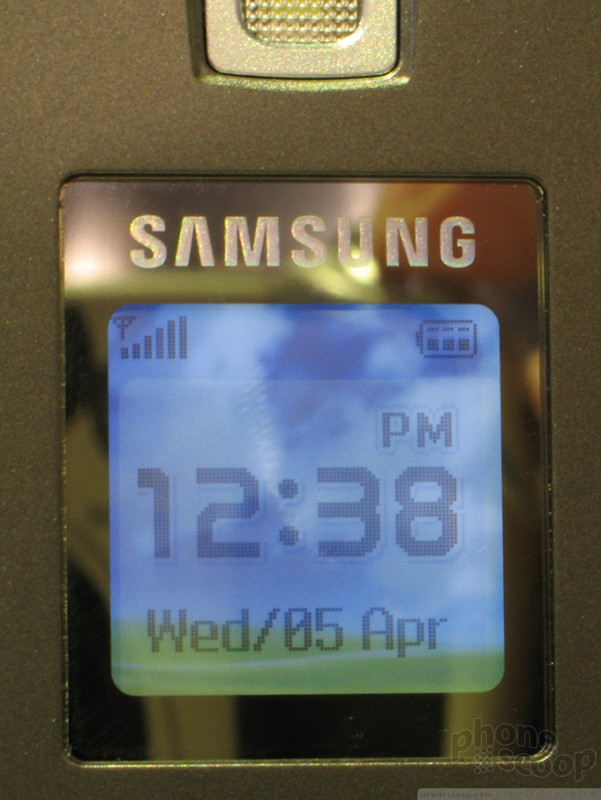
It only shows up when the backlight is on, but it has the same kind of green grass / blue sky thing going on that the LGs have. This kind of gimmick seems somewhat out-of-place on a business-oriented phone like the T719.
Samsung announced the D407 officially, although we reported on that last month, and we didn't discover anything new about it.
Also on display was the A930. We first covered this back at CES, but since then the color has been changed to all-black:
I personally preferred the sleeker two-tone design, but the black version has a kind of sci-fi look that some people might like.
Jitterbug
One of the most unexpected and interesting announcements at the show was Jitterbug, a new MVNO from a little-known company called GreatCall. The target market for Jitterbug is older users, especially holdouts who have resisted getting a cell phone so far.
Actually, while older users are the expected users of this service, the target market may be slightly different. Much the same way Disney Mobile will actually be marketed to parents rather than kids directly, Jitterbug looks like it may be marketed toward adults to buy for their aging parents.
The one thing Jitterbug really has going for it is the phone itself. While other companies have talked about MVNOs or service for older users, GreatCall seems to have actually done a good amount of research into what older users need in a phone, and they've worked with Samsung to create a custom phone just for Jitterbug.
Jitterbug will actually launch with two phone models, although they are simply variants on the same design. The Samsung A120 is the standard model with a numeric keypad, while the A110 is the super-ultra-simple version with just three large buttons to dial "Operator", "Home", and "911". The Operator key connects to a real human operator. The phone can also be ordered with labels like "Friend" or "Tow" on the middle key instead of "Home", and that key is pre-configured to dial the number of your choice.
The overall design is rather large, but that makes the phone harder to lose, and much easier to manipulate for those whose hands don't quite have the dexterity they used to.
Those with less-than-perfect hearing will appreciate the extra-loud speaker. There's also a rubber cushion surrounding the speaker area. Although it looks kind of odd, it cups around the ear to block our background noise and make it easier to hear the sound. The idea is just like those big, cushioned headphones that DJs use.
The phone is full of thoughtful touches that make it simple and intuitive to use. A large rocker switch on the outside makes it easy to adjust or silence the ringer, so you don't have to open the phone and fiddle with settings. A very clear "on/off" key is provided above the main keypad. This addresses the (surprisingly common) issue of first-time users not knowing how to turn most phones on and off.
The UI is almost as simple as it gets. The default screen is the contacts list. Everything else is only presented when necessary, and the interface only requires the very simple yes/no and up/down keys.
An especially unique feature is the dial tone, which lets first-time cell phone users start using the phone right away with zero learning curve.
Jitterbug won't start commercial sales until the fall, although they plan to run limited trials this summer.
UTStarcom
We went to the UT Starcom booth not expecting much, but they managed to give us a few surprises.
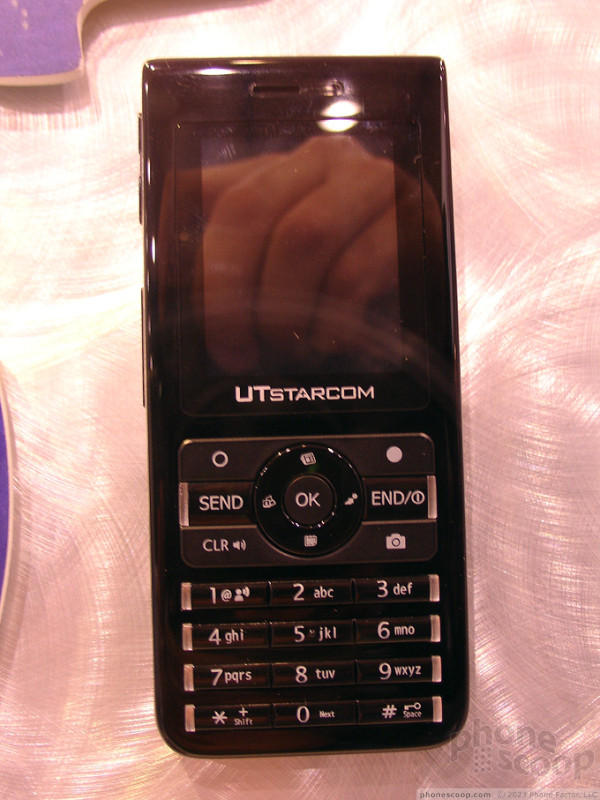
Today a new phone mystically popped up at the UT Starcom booth - it wasn't even there yesterday. The 9250 is yet another thin candybar phone with a VGA camera. It looks much more polished and well put together than a simple SLVR knockoff, possibly because this handset is a KT Freetel produced unit. It has a MicroSD slot, VGA camera, BREW and all sorts of other features that could mean it's coming to Verizon. However UT Starcom hasn't even announced or launched it yet, let alone a carrier. The 9250 was behind glass so we couldn't sneak a peek at the software either.
UT Starcom hasn't officially launched the 7945 yet either, however there was one the floor with Verizon sotware on it, which comes as no surprise. The 7945 will be the first mid-range phone they launch produced by UT Starcom. It has a 1.3 Megapixel camera as well as a MicroSD slot and external music controls. Oddly the unit we played was not flashed with the music player, just the basic Verizon interface, so we didn't get to test the playback controls.
We didn't really get to test the software on the G'Zone either, but we did get to dunk it in water while it was running a demo loop. The G'Zone UT Starcom was showing off was still the Japanese version available through KDDI with a Japanese keypad and KDDI service labels on the keys. Even though we couldn't use it, we could at least get a feel for it. The G'Zone was a little larger than a VX8100, but it didn't feel huge. It is still easy to wrap your hand around it, and has a solid feel without being too heavy. Of course the most remarkable thing about the G'Zone isn't the size or build quality, but the fact that you can dunk it in water or drop it to the ground and the phone will keep going.
After seeing the G'Zone emerge in perfect working order from a dunk-tank, it wasn't just we who were impressed. Several people from other well known companies in the mobile world were drooling and ready to lay out money for one.
Part 3
Disney Mobile
It was awfully tough to squeeze all the Disney Mobile news into a tiny paragraph on the front page, so we're glad we can tell you more here.
MVNOs these days are targeting tightly-focused age groups. Disney Mobile wants young children, what marketers call "tweens" and young teenagers - kids from about 8 to 14 years old in non-marketer speak. These kids are obviously too young to buy their own phone, so Disney is not so much going after the kids as targeting the parents of the kids by trying to address the concerns of modern day tech-friendly middle-aged adults. This is going to be a popular target as Jitterbug will likely want to sell these same folks phones for their parents.
Disney will launch this summer online and in mall kiosks around the states. They will be pushing family plans pretty hard because they've designed the menus in their phones to optimize control and messaging for the whole family. From the "Family Center" menu on the phone, parents can locate their kids, control their use of minutes and data spending as well as message the whole family. When a family message is received or an alert is received about a child's spending, the message takes over the phone's home screen, requiring the parent or child's full attention.
Disney is not so unrealistic as to believe parents will simply drop their current phone and plan to be on Disney Mobile with their children, so they will also offer individual accounts which the parents can control from a web interface.
Disney will launch their service with the P100, an unfortunately bland phone. It is a rather old-school looking silver clamshell that looks and feels too much a like a two year old Samsung. Other than the Disney service, the only thing notable about this P100 is the VGA camera (with flash) and an external color LCD. It is most likely meant to be an expensive, durable unit for young kids, but the design still could have been more interesting or innovative. The menus certainly are.
Because Pantech is Disney's launch partner, the MVNO is exclusively advertising this phone, so it is difficult to say whether LG's more current handset will be available at launch as well. The L200 is the more grown-up of the two handsets. Based on LG's LX350 for Sprint, the L200 features a 1.3 MP camera, Bluetooth and more modern styling. The only difference between the LG350 and the L200 - other than the software - is that the cover is now red instead of black. This means the external LCD is no longer sleekly hidden in the face of the clamshell, but the red is friendly looking without being childish. We were pleasantly surprised that Disney did not disable the Bluetooth.
Disney will sell the P100 for $60 and the L200 for $110 with two year contracts. They did not discuss whether they will launch additional models this year, but the word is that one or two more will be available before year's end.
Both phones, and most likely all future models share the same menus / software. The main menu and each application menu has been simplified to five choices with limited sub-menus as well. Many applications found in modern phones have been simplified or eliminated altogether. But despite this simplification, the phone's menus do not feel dumbed-down, simplify clarified. As with the other new UIs shown at CTIA, we captured a video of Disney Mobile's menus. It's a short 40 seconds you can watch here:
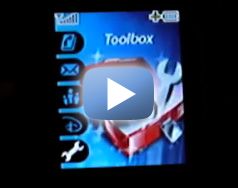
QuickTime format
Motorola
We'd really love to bring you tons of info on new Motorolas, but unfortunately Moto didn't really give us a whole lot to work with.
Motorola CEO Ed Zander announced a while back that he wants to start keeping phones secret until they're almost ready to ship. That's not easy in this industry, but he appears to be following through and trying his best, hence the lack of new phones at trade shows this year.
There was some news, though. The most exciting new phone is the i580 for Sprint Nextel's iDEN network. This is easily the most feature-packed ruggedized phone ever brought to the consumer market.
They really mean it when they say "ruggedized", too. This isn't just a regular phone with some rubber grips tacked on; it actually meets military spec for resistance to water, dust, and shock (being dropped). Motorola has offered such protection for its low-end phones before - and it's not a big deal for a no-frills bar-style phone - but it's pretty impressive for a clamshell phone with features like a megapixel camera and microSD memory card slot. Rugged usually means compromising on features, but certainly not in this case.
The feature list continues with Bluetooth, a music player, and whole slew of new and strange "push-to" features. (I can't say I really understand the benefit of sending text messages over the PTT walkie-talkie network as opposed to the regular cellular network.)
The i580 is a good deal larger than the i560, but between the extra features and the shock protection, that's to be expected.
The i670 (above) is the other new iDEN phone Motorola showed at CTIA. It's pretty no-frills, right down to the lack of an external display, but it's pleasantly small and light. It's pretty much a replacement for the i710, but dramatically smaller.
Moving on to CDMA, we have the W315 and C290. Since the C290 went on sale with Sprint right before CTIA, the W315 is the only real "new" one.
There's not too much to say about the W315. It's a basic clamshell phone with an external display. It's quite stylish - almost PEBL-like - and the ergonomics are great. It feels solid and the keys are excellent. It has BREW, but few other features.
At first glance, the W315 and C290 might seem like pretty much the same phone, just with and without the outer display. But upon closer inspection, they seem to have been developed separately. The keypad, hinge design, and connector placement are quite different. There is also a size difference. The C290 is a nice, small phone, while the W315 is a tad bigger. Size is the C290's only advantage, though; the keypad isn't as stylish or ergonomic as the W315, and the lack of an outer display is annoying.
The last thing worth mentioning is the significance of the C290 in Sprint's lineup. It's significant for Sprint simply as their first new phone in four months. It's not unusual for there to be a lull in carriers' lineups after the big holiday push, but four months without a single new phone is a bit extreme. Phone technology changes too fast to let a lineup stagnate like that.
What's more significant is that the C290 is Motorola's first phone for Sprint in quite a while. Motorola used to have a good relationship with Sprint in the StarTAC days, but then they had trouble with their home-grown CDMA chipset when Sprint moved to 1xRTT. Motorola ended up switching to Qualcomm chips, but they had trouble with that at first, too, and they fell out of favor with Sprint. They tried again a couple of years ago with the V60v, but that didn't seem to go very well.
Now that Motorola seems to have regained their footing in CDMA, (phones like the E815 generally have top-notch performance,) Sprint seems willing to give them another shot. It's pretty typical for a carrier to test the waters with low-end phones when starting up a relationship with a new manufacturer, so it's not surprising to see the C290 instead of something higher-end. But if the C290 performs well, we should see higher-end phones from the two companies down the road.
RSS Readers
Once the domain of tech geeks, RSS is now becoming a mainstream technology. On the web, RSS reader software and aggregator web sites are a great way to keep track of new content on multiple sites all in one place. If you have multiple web sites you check daily for new info and you're not using RSS, you should look into it. It can be a huge time-saver.
Since RSS feeds contain an efficient, simple stream of just the latest information, they seem like a perfect technology for delivering up-to-date info directly to phones. That's why, since the dawn of RSS, mobile tech heads have been begging for good RSS software on mobile phones.
Well, Nokia and Sony Ericsson are finally listening. An RSS reader is now standard in Nokia's S60 3rd Edition smartphone OS, and also on Sony Ericsson's forthcoming high-end feature phones like the K790. RSS reader interfaces can vary wildly, however, so we wanted to see exactly how Nokia and Sony Ericsson actually implemented them. So we set out to put each reader through its paces and give you an up-close-and-personal tour of both.
Let's start with Nokia, using an E61:
The basic interface used by both Nokia and Sony Ericsson is pretty straightforward, and pretty similar between the two. There's a list of feeds, then going to a feed you see the list of headlines, and then you can drill down to individual items.
That pretty much sums up the Nokia reader. Each item is on its own screen, so you need to press the "Back" soft-key to see the list of headlines again. However you can scroll through items without going back to the list, by pressing left or right. (Indicated in the third screenshot above by the "7/20" and arrows at the top of the screen.)
Because it's RSS, the whole feed is always downloaded all at once. That means opening an item is instantaneous, as is scrolling from one item to the next. That alone makes RSS a massive leap forward over using WAP to stay on top of the news.
Selecting "See full story" opens the attached link in the full web browser (another cool feature of S60 3rd Edition).
The Sony Ericsson reader is a little more advanced. We took it for a spin on a K790:
Sony Ericsson steps it up a notch from the very first screen. The list of feeds includes the web site's graphic icon - the same one displayed in the address bar and bookmarks menu in a PC browser. It also shows the date and time of the last feed update. How often to refresh the feeds is configurable, and you can force one or all feeds to update at any time.
Selecting a feed displays a list of headlines just like the Nokia, although the Sony Ericsson wraps the text so you can see the full headline, instead of just chopping it off. It also displays the feed's graphic badge at the top (usually the site's logo).
Clicking a headline expands that item right within the feed, instead of going to a new screen. That lets you simply scroll down the whole feed from top to bottom in one pass, only expanding the items you're interested in based on the headlines.
Sony Ericsson also supports images in the feed, which is nice since many feeds now include images. There are even an increasing number of feeds on the 'net that rely heavily on images, and would be pretty useless without them, so it's nice to know you can access all feeds and see everything you're supposed to on the Sony Ericsson.
Like Nokia, a link at the bottom will open the URL for that item in the phone's web browser.
As you can see, both phones had no problem with Phone Scoop's RSS 2.0 feeds, although only the Sony Ericsson rendered the images. While Nokia's RSS reader is part of its new full web browser application, Sony Ericsson has the RSS reader as a function within the Messaging menu. That might seem odd, but does make some sense since RSS is all about small bits of (almost) push-style, time-sensitive information, just like SMS and email.
One last little bit of info we picked up at the show about RSS: apparently Cingular is carefully planning how to handle these new RSS-capable phones. They intend to charge an extra $10 per month to use the feature, even if you already have an unlimited data plan. That sounds pretty outrageous to us, and we don't quite understand how they could technically enforce such a scheme, but that's what we were told, and the source was quite reliable.
Part 4
Windows Mobile
One of the more interesting phone announcements at CTIA was the HTC Foreseer. This is a Windows Mobile Smartphone optimized for TV viewing.
It's designed to display live TV, broadcast over DVB-H. Specifically, it's designed to work with the DVB-H network being built in the U.S. by Modeo, broadcasting on its own 1.6 GHz radio frequency band. Modeo is the new TV-oriented arm of Crown Castle, one of the largest independent owners of cell phone towers in the country. DVB-H is a competitor to MediaFLO, Qualcomm's live-TV system. Modeo expects to launch its network in 30 cities by the end of the year.
Aside from DVB-H, the Foreseer is a typical Windows Mobile Smartphone. It shares most of the feature set of the T-Mobile SDA and Cingular 2125. The obvious difference is that the display is rotated 90 degrees to landscape orientation, so you don't have to turn the phone sideways for a good full-screen TV viewing experience.
The form factor may look strange, but it makes sense for a device like this. It's a nice size. In the world of smartphones, it's a bit like the Motorola Q. It's a bit thicker than the Q, but smaller in the other dimensions. It's very close in size to the newest iPod.
It offers good standard connections, including a mini-USB connector and a 3.5 mm audio jack, so you can plug a pair of high-quality stereo headphones directly into it. The device is light, but felt solid. The keys felt great.
Using the TV functions is very easy. The ESG (Electronic Service Guide) software is made by Penthera. It could be a bit prettier, but it's very functional and easy-to-use. Just like cable or satellite, you see a grid of current and upcoming programs, and choosing one changes to that channel. The ESG includes a live-TV box so you can keep watching TV while you browse for something else to watch, or just check to see what's on next.
In other HTC news, the company revealed that it plans to bring its "Star Trek" clamshell smartphone to the US by mid-year, and an HSDPA version of its "Hermes" PDA-phone to the U.S. later in the year. The Hermes is a successor to the T-Mobile MDA and Cingular 8125. A true 3G version of that device is a pretty exciting prospect.
HTC wasn't the only manufacturer showing off new Windows Mobile devices. Chi Mei also had a new Smartphone at the show. The unnamed device was a prototype smartphone with UMA technology for seamless roaming between GSM networks and personal Wi-Fi networks at home.
The Chi Mei UMA phone is surprisingly small. It seems smaller than recent HTC smartphones like the SDA and 2125. Its features are pretty standard: 1.3 megapixel camera, Bluetooth, memory card slot, etc.
This isn't the first time Chi Mei has shown off such a phone at a trade show. They had a clamshell version of this phone at 3GSM over a year ago. We'll see if this one has better luck making it to market.
Pantech
Unlike UT Starcom, who is happy to remain at the low end of things, Pantech is not willing to sit back and let US carriers tarnish its good name. They are working hard to get some higher end handsets in the US. The Helio Hero will, of course, be the first - but certainly not the only - high-end handset from Pantech to arrive on our shores this year. Rumor has it that later in the year, Helio could launch additional high end Pantech models, but the company did not talk about those plans.
Instead Pantech executives let it slip that the company will be bringing an EV-DO and MediaFLO phone out near the end of this year. Since Verizon has announced it will use MediaFLO and already offers Pantech handsets, it's likely this model is meant for Verizon. The FLO phone that comes to the US will be based on the EI1, a FLO phone produced for SK Telecom.
The EI1 is a slim slider with a 2 Megapixel camera. It felt light in the hand, and cool to the touch, which is surprising considering how warm handsets tend to get when streaming TV. The screen is large and bright but we can't tell you much else about this phone. Pantech wasn't particularly forthcoming with specs, and what specs they could offer were still up in the air. For instance it still wasn't decided whether the phone fill use EV-DO Rel. 0 or Rev. A.
Pantech also accidentally announced that it will start selling phones to Cingular. Cingular, like Verizon, will start with the low end of Pantech's lineup, possibly one of the models they showed at CES. However they should have an HSDPA model on Cingular by early next year. Pantech brought along a few of its mid-range GSM phones to show off.
The G3600V is a slider that looks like yet another black iPod knock-off when closed. It has a smooth face with a scroll pad and 2 softkeys which slides open to reveal a fairly normal keypad. It also has a 1.3 Megapixel camera with a sliding cover and Bluetooth.
The G6200 is a sleek looking clamshell that makes no attempt to copy the RAZR, which was a refreshing change. Instead the 6200 is designed so that when it is opened, it presents a smooth curvilinear profile. It sports a 2 Megapixel camera and Bluetooth. It also has a fingerprint scanner to secure the phone, which is getting a great deal of resistance from American carriers, so it is unlikely this model will ever see our shores.
more LG
In addition to the phones LG officially announced which were prominently featured at their booth, we spotted a few more on the show floor.
The AX390 is an upgraded AX-4750. Like the the 4750, it is an Alltel phone with Kodiak Push To Talk and a large speaker in the center of the clamshell hinge. The 390 doesn't seem to actually upgrade any features, it just updates the design. (At least based on the limited info LG would provide on the phone.) However the new design alone is a much-needed update, as the design of the 4750 was rather clunky.
When meeting with Kineto to discuss upcoming UMA plans for the US, we had chance to play with the LG CL400.
Like the Samsung T709 and Nokia 6136, the CL400 is a rather ordinary handset. (Is it just us or does it look like a less slick LG350?) Like the others it will be able to seamlessly handoff voice and data calls between the GSM network and Wi-Fi hotspots. We confirmed that T-Mobile will definitely launch UMA in the US, but it is not clear whether this model will be part of their offering, considering T-Mobile doesn't regularly offer LG handsets.
Additionally we were told that Cingular was seriously considering UMA, however once AT&T announced it would become sole owner of Cingular their interest in UMA waned severely. This seems at odds with the advantage of UMA, which would let AT&T make the most of its landline network and hotspots, leveraging it to lighten the cellular load. This LG as well as UMA version of the N80 were almost certainly created with Cingular in mind. The LG model even starts with a C, a sure sign it was meant for Cingular.
At a separate Nokia demo, we were shown how UMA doesn't require a special access point; all it requires is a WEP connection between the phone and an access point, even an off-the-shelf one. When in range of a hotspot it has the password for, the phone will automatically establish a connection, tunnel into the UMA server over Wi-Fi and transfer the call.
Nokia GPS
All CDMA phones sold in the States these days have GPS technology. When people hear that, many of them want to know if the phone can display your current latitude and longitude. However it works a little different than a standalone GPS unit that you might use for hiking, etc, so unfortunately the answer in most cases is no.
There are a few phones starting to hit the market with GPS APIs for Java or BREW that enable LBS (Location-Based Services) to run on the phone that can do mapping, etc. (The Motorola V323/V325 and Sanyo 7500 are two of these phones.) Yet these applications still require help from the network, so these phones still do not come with the built-in ability to display your coordinates.
But a couple of new Nokia phones are about to hit the market that change that. Not only will they work with third-party Java or BREW LBS software, but they also have a standalone GPS mode, and come with a built-in set of GPS tools that can display your latitude and longitude, and much more.
The just-announced (and very sleek) 6175 is one of the phones with this feature. The other is the 6165, which we hear will launch with Sprint very soon.
The basic display shows a neat graphic indicating which GPS satellites you're receiving data from and the signal strength. Because it works in standalone mode, it takes a little while to get a fix, and it doesn't work well indoors. (The same is true for standalone handheld GPS units.)
Another application helps guide you to a predefined location (like a camp site or geocaching waypoint.) Yet another provides a "breadcrumbs" function to help you find your way back the way you came. A "trip computer" function gives you a readout of data on where you're going and where you've been, just like a car's trip computer.
The tools don't include full mapping and turn-by-turn directions, although these phones will work with third-party software that does that, and Nokia was demonstrating such software at CTIA.
It's up to carriers whether to include this suite of tools or disable it. We really hope carriers like Sprint and Verizon choose to leave it in. It would be great to have a phone to recommend when people ask for a small phone with "real" GPS.
Comments
ZOMFG can't wait for Helio...
VX8400???
The FCC site shows that the VX8300 was submitted on 03/03/06 and the VX8400 was submitted on 11/18/05.
However, there is no mention of the VX8400 from CITA.
The FCC site says the External Test Photos for the VX8300 will be up available on 10/14/06, and the External Test Photos for the VX8400 on 05/17/06.
http://home.comcast.net/~dougsmithfl/vx8300a.jpg »
http://home.comcast.net/~dougsmithfl/vx8400a.jpg »
I was expecting the 8400 at CTIA, too. Since it wasn't announced, I'm g...
(continues)
To Rich or Eric
There was less hype. It was almost quiet.
I was wondering if you felt that and if you think that this is a hiccup for 2006 or an ongoing trend?
I think it was just the venue. Because CES is in the same place, and a lot of the same people go to both shows, people might have been subconsciously comparing it to that. CES is so insa...
(continues)
Future Helio Handsets (Samsung?)
Are we supposed to start thinking SLIM A900 with more features here?
Sammy may be king in SK, but honestly the carriers themselves seem to ...
(continues)
Nokia GPS
I'm going to say that they will disable it since there would be a competing BREW program
Jitterbug and GreatCall
I couldn't have imagined before working at a wireless carrier stor...
(continues)
RE: Cingular trying to charge for RRS feeds
RSS Readers
Rich, both LG LX-550 and VX-8300 support stereo Bluetooth profile (i.e. A2DP)
http://qualweb.bluetooth.org/Template2.cfm?LinkQuali ... »
And here is the LG VX-8300 entry.
http://qualweb.bluetooth.org/Template2.cfm?LinkQuali ... »
Both qualified profile lists show A2DP-Source so they support streaming stereo Bluetooth.
The 8300 definitely does, and I think we said that (didn't we?).
The 550 does not, according to the LG spec sheet I'm looking at... 😕
That video does not work!
(continues)
Any New Sanyos?
(continues)
Samsung SPH-A960 TransFlash?
The Samsung spec sheet they handed out to everyone says very clearly:
"Transfer your favorite tunes in MP3 format onto the removable microSD(TM) memory card"
...but when playing with it today, I couldn't find the slot....
(continues)
I guess I'm stupid
Having gone to CTIA.....
They had a killer slim blackberry (7100t type keypad) that was major slim.
They also had their first HSDPA phone that will go into production ZX20. It has a disappointing form factor that was reminiscent of the SS ZX10 but heavier, the LG HSPDA device, which is coming out at the same time is much more compelling (but was not shown). I like their jewelry store concept but I am not a fan of the fugly jitterbug. That is a huge monstrosity that could have been executed better.
Second was a tie between LG and Sony Ericcson. While I've seen pictures, sometimes you just have to see the phones in real life. I rea...
(continues)
Picture of VX8300 OLED Display?
However, it would be nice to see a picture of them with the external displays turned on
so we see the VX8300 OLED next to the VX8100 TFT.
...so we see the VX8300 OLED next to the VX8100 TFT.
They wouldn't look any different. I couldn't see any significant difference in person, and it's nearly impossible to really capture display quality accurately in photos any...
(continues)
Helio
lg
Rich - Q about Helio phones...
When you had your mitts on the two Helio phones, were the screens the same size? Specs for the SK version of the Kickflip (can't remember the exact model number now, it's a VK Mobile phone - 650 maybe) state the screen is 2.2", and I also read that the Hero specifically had a 2.2" screen.
Of course, for whatever reason in all the photos the Hero appears to have the bigger screen, but it may just be due to the design and color.
=)
motorola and samsung
Moto and Samsung ha...
(continues)


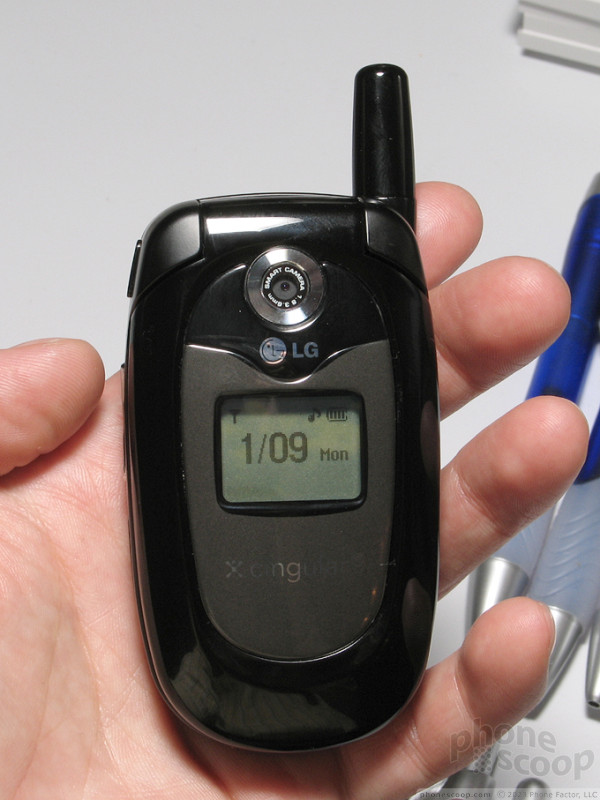



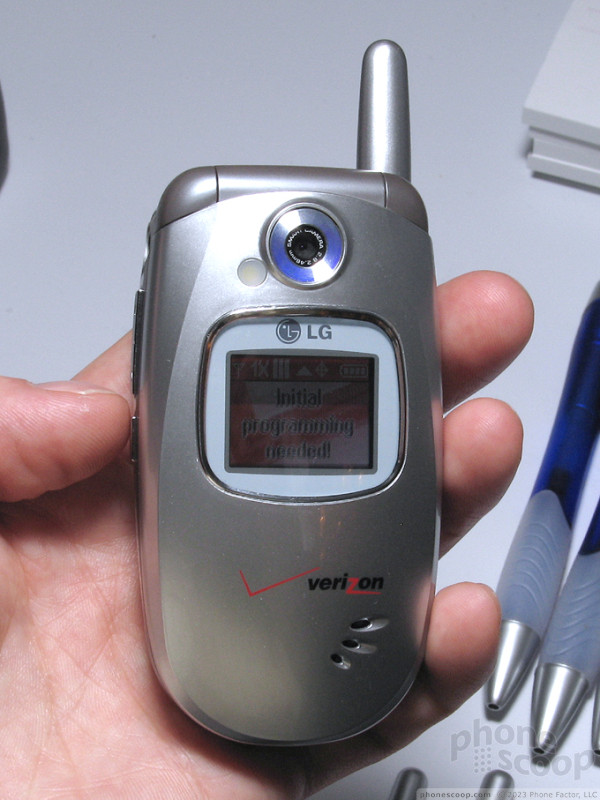



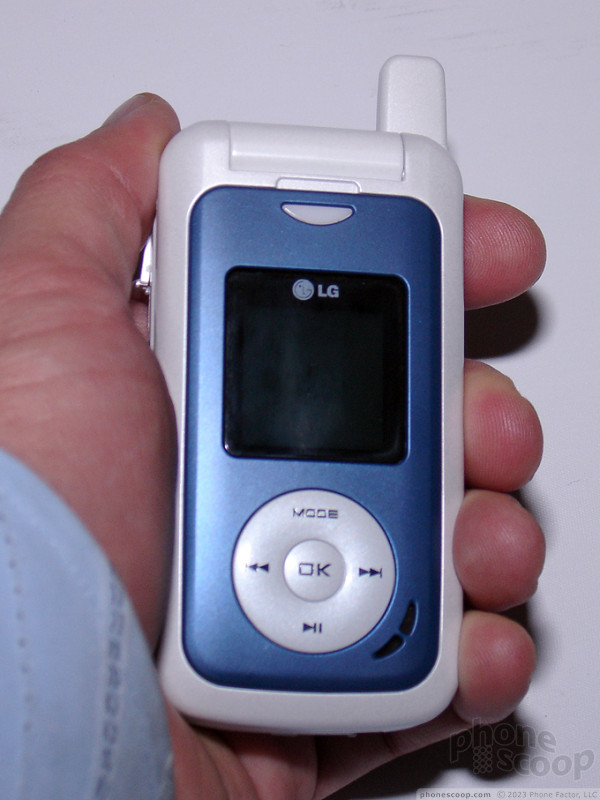








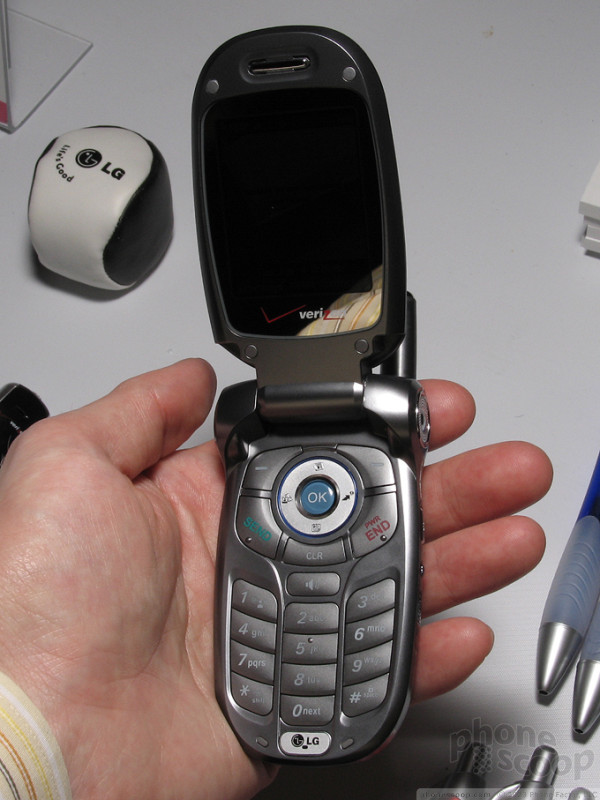






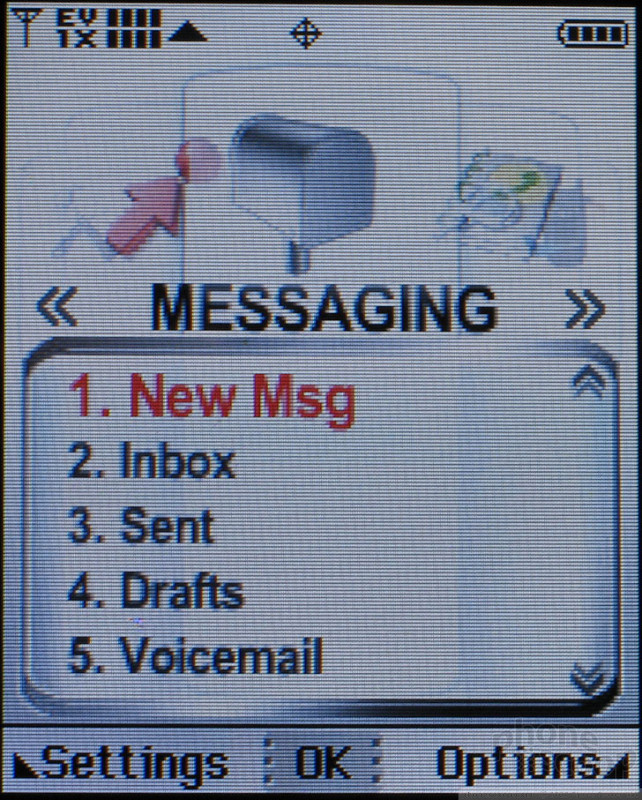




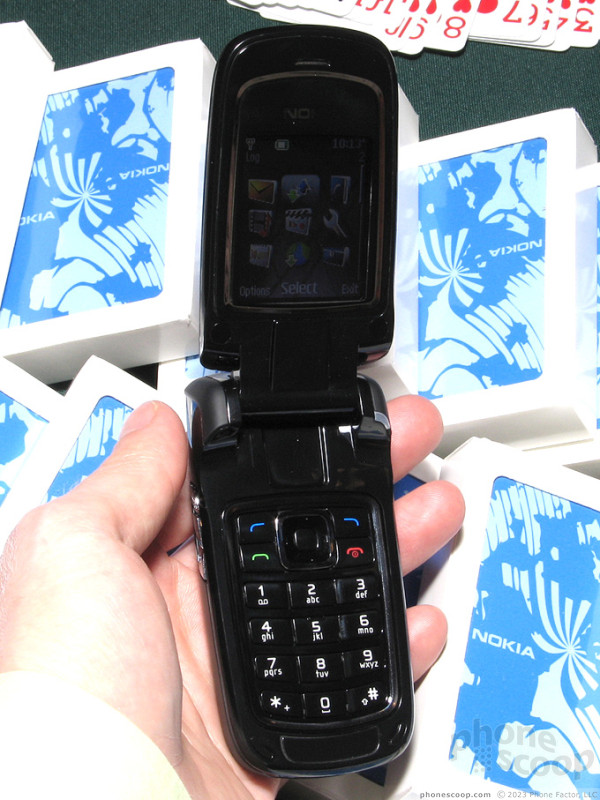







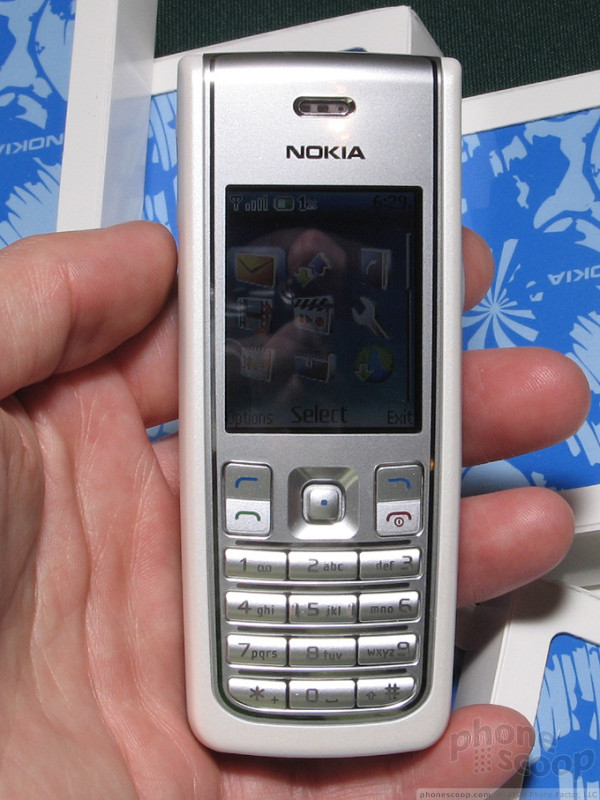









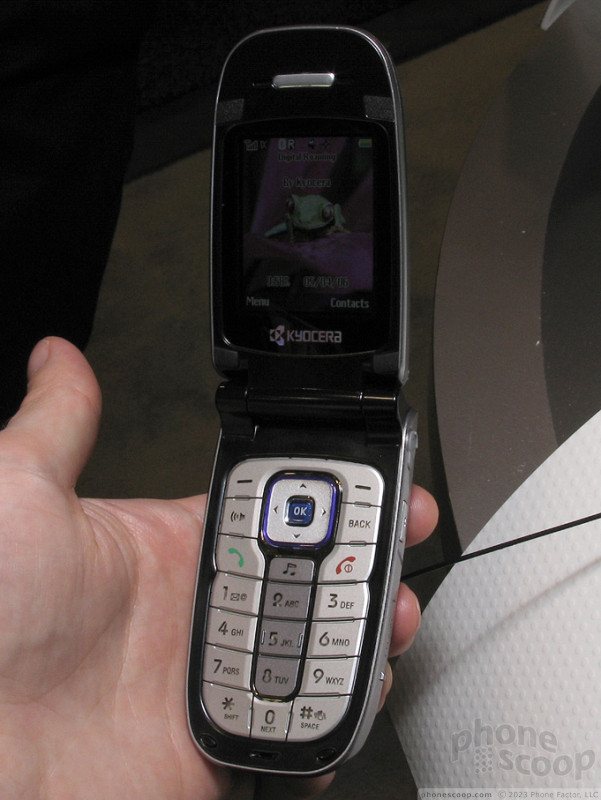




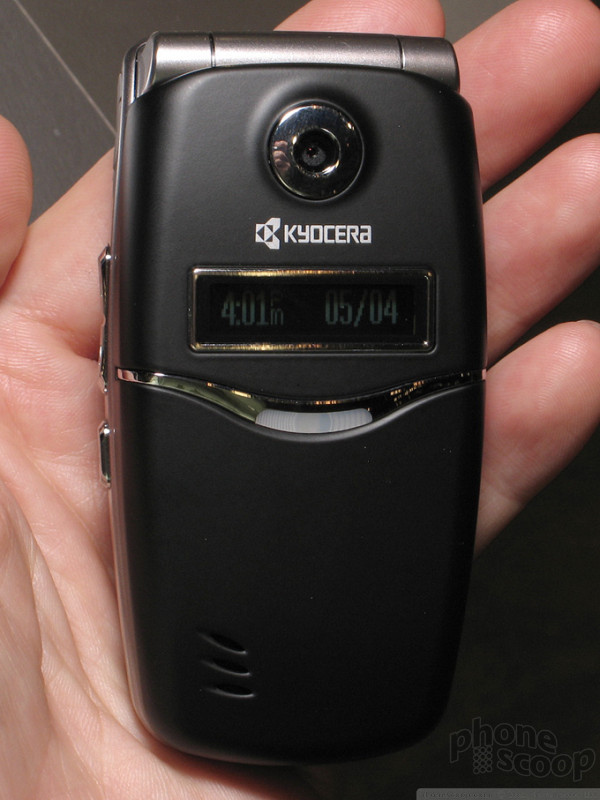










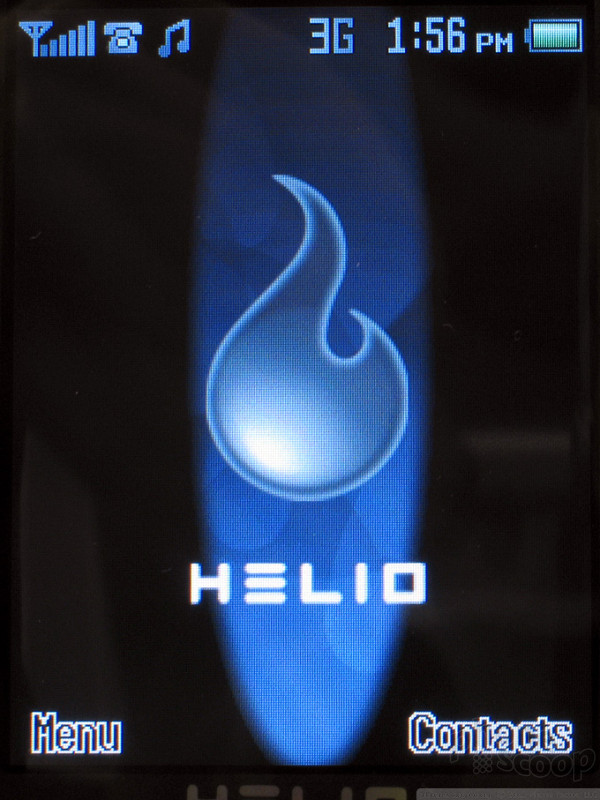











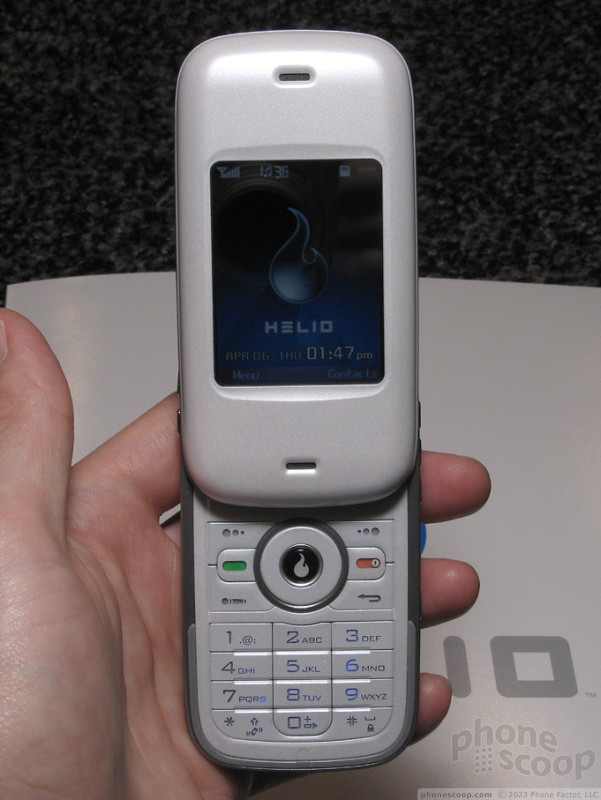

















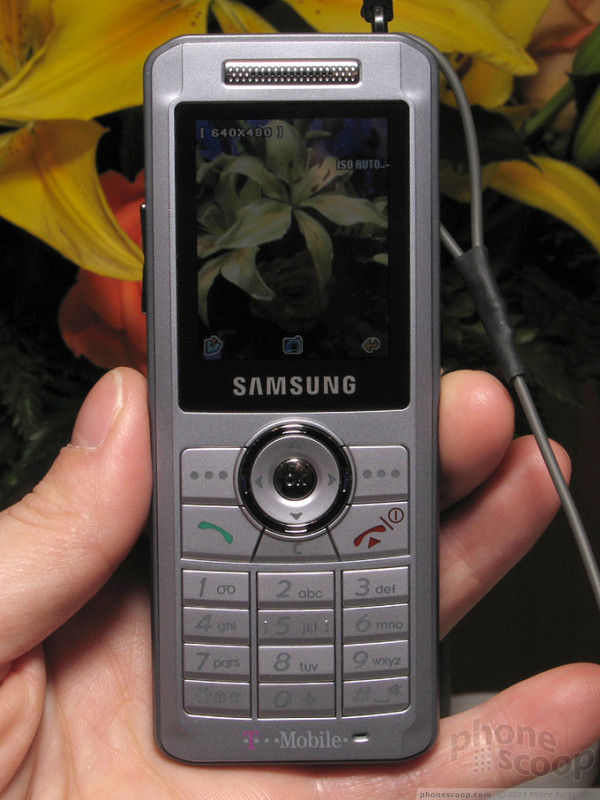







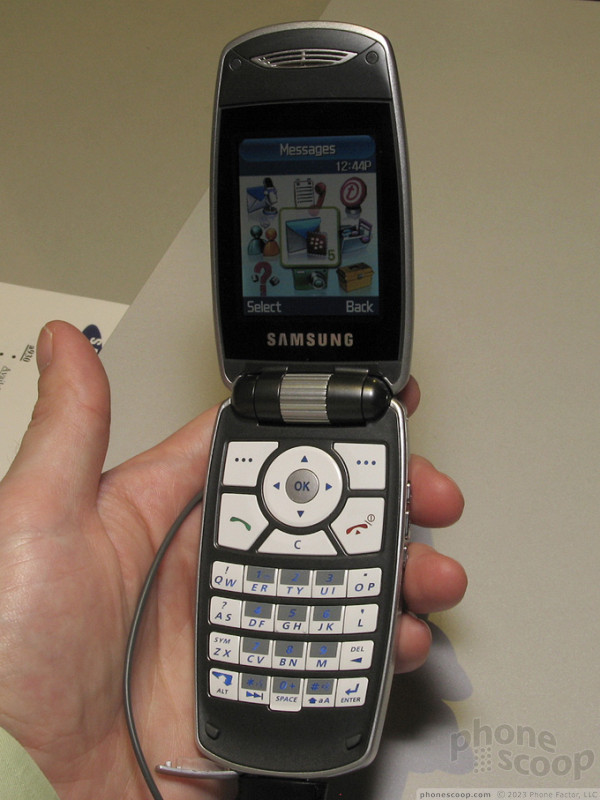







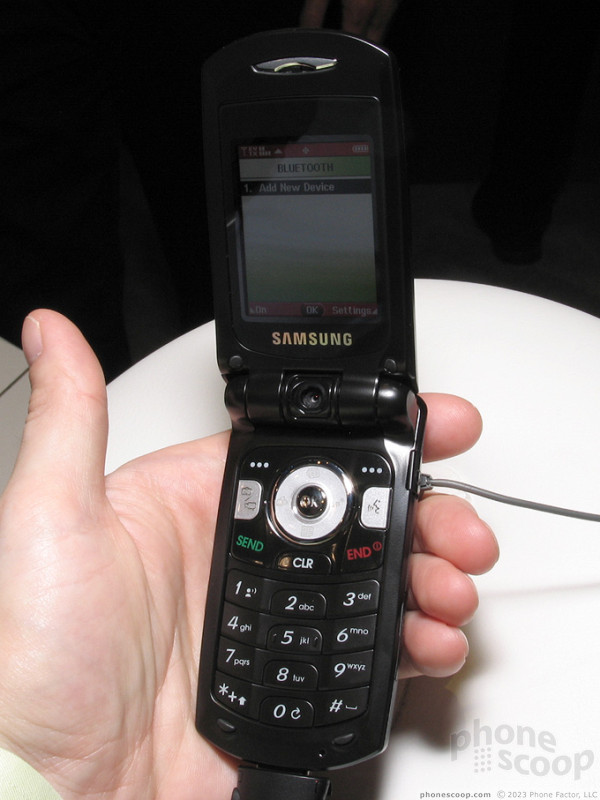









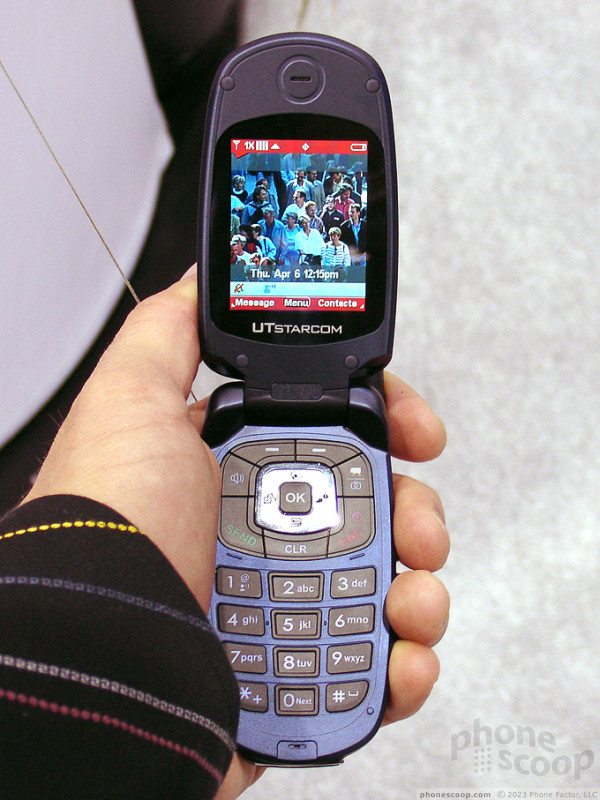





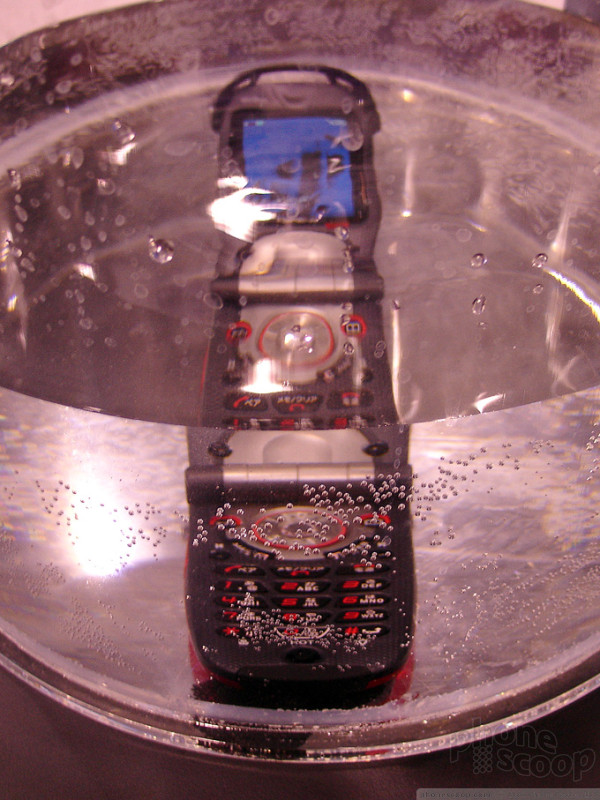





















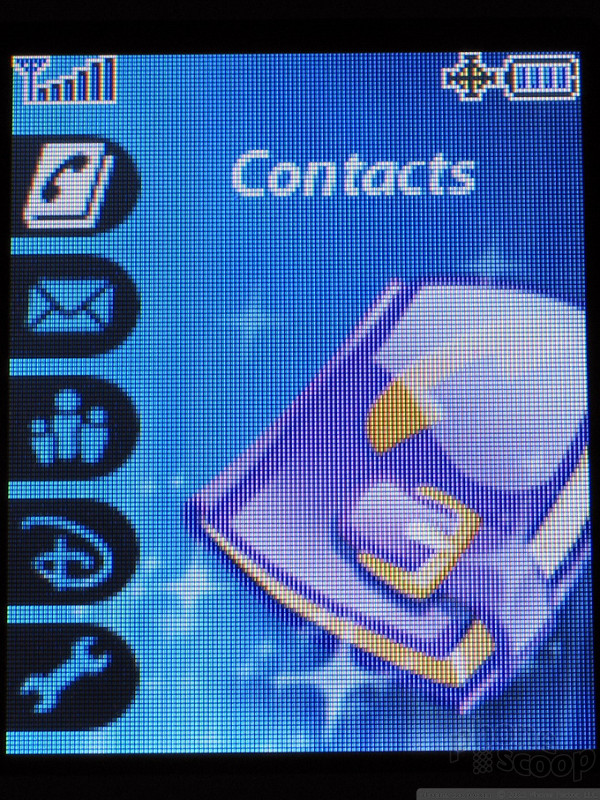





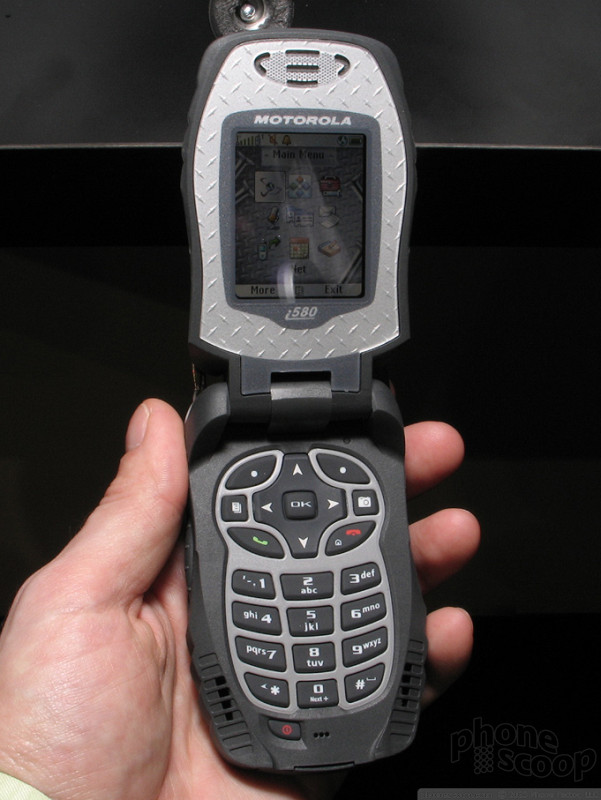






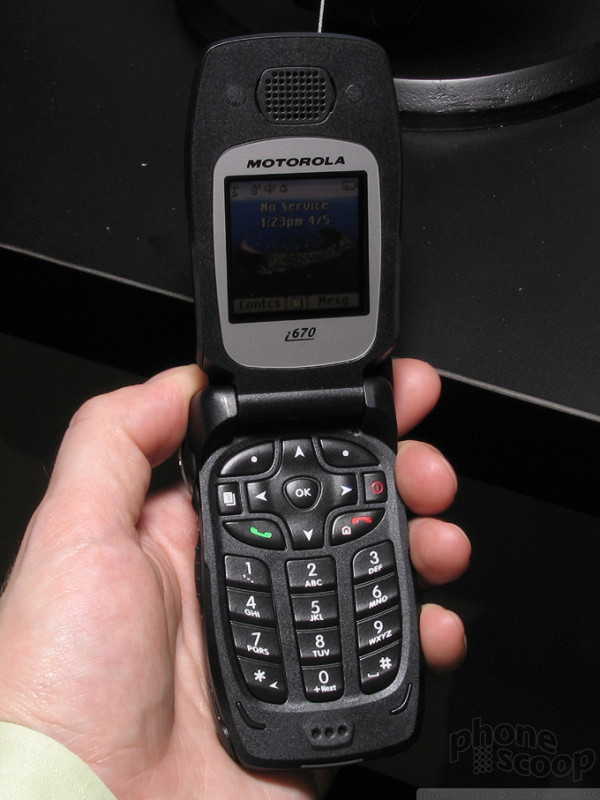



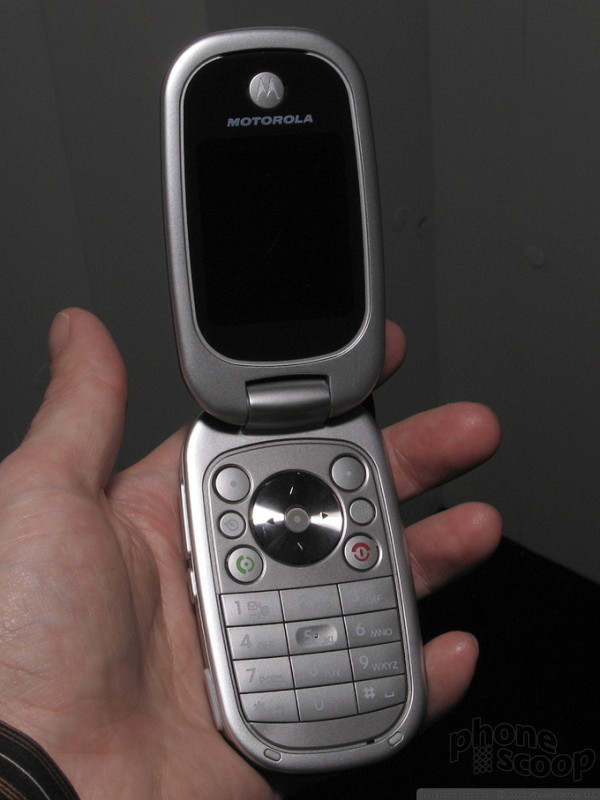











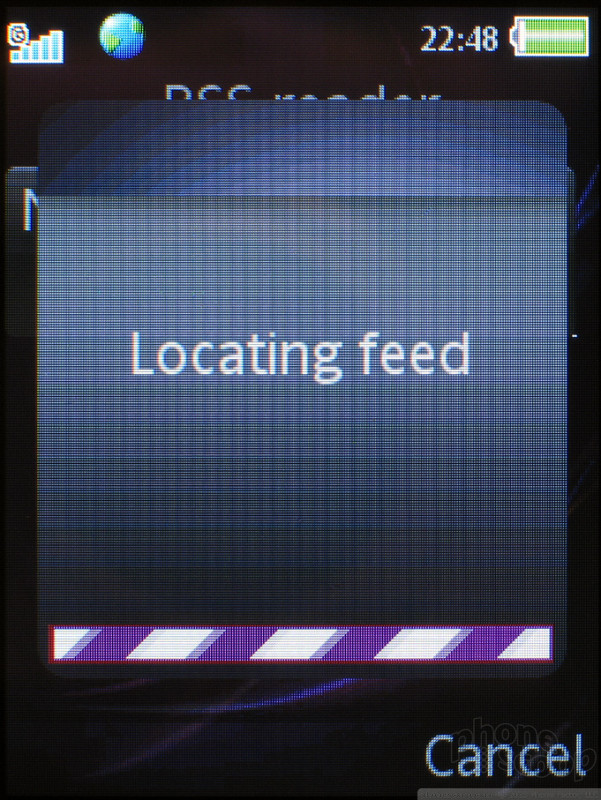









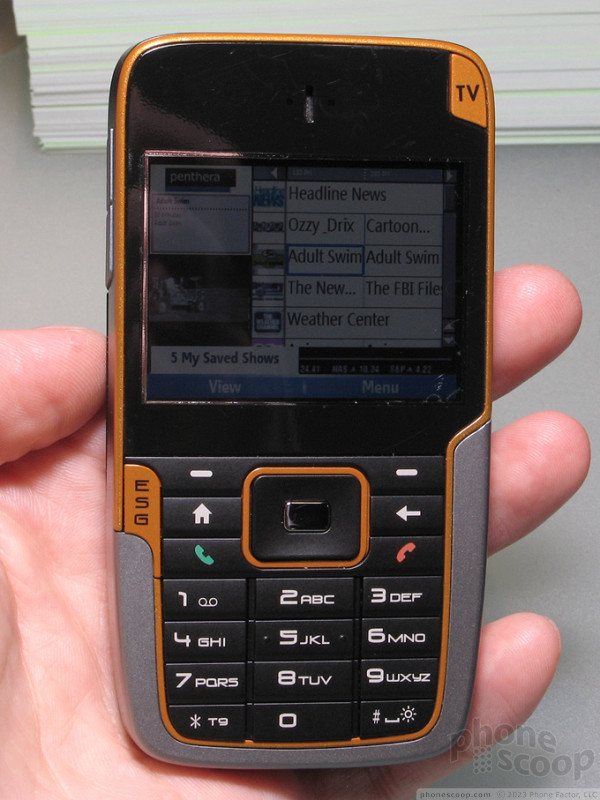






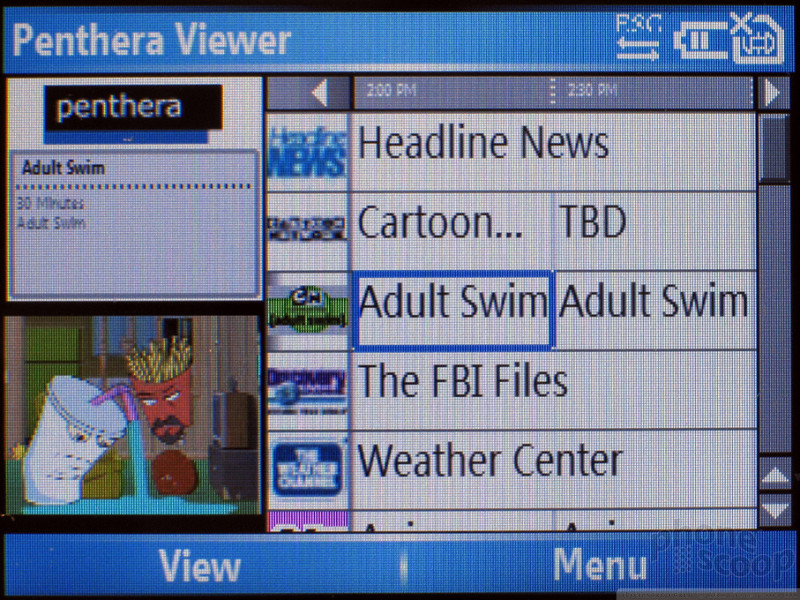




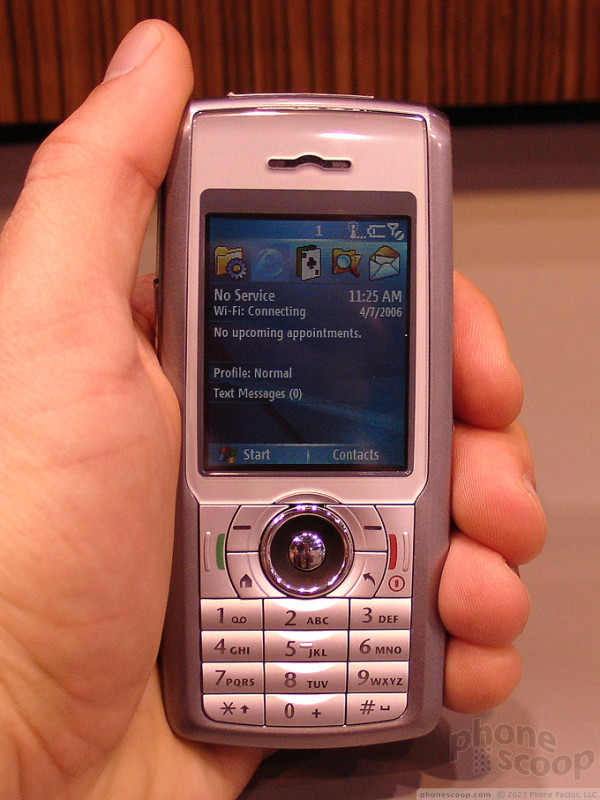



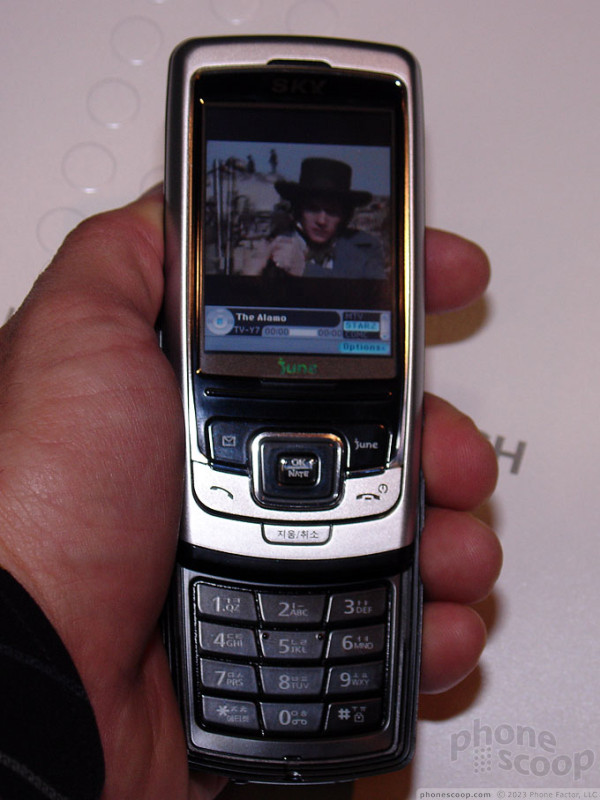











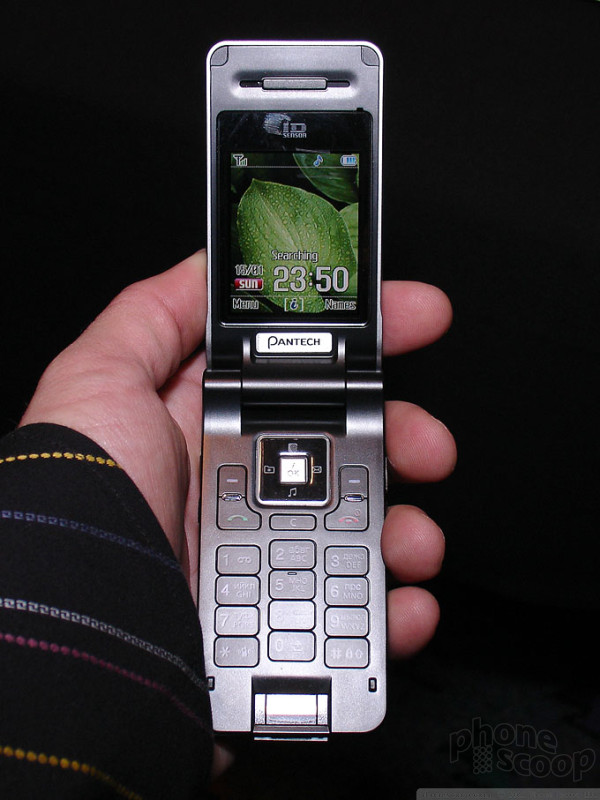



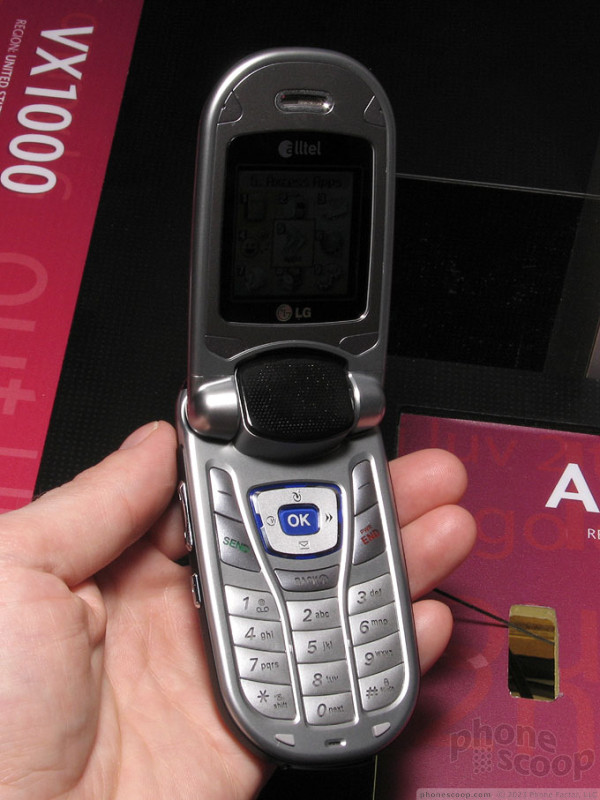









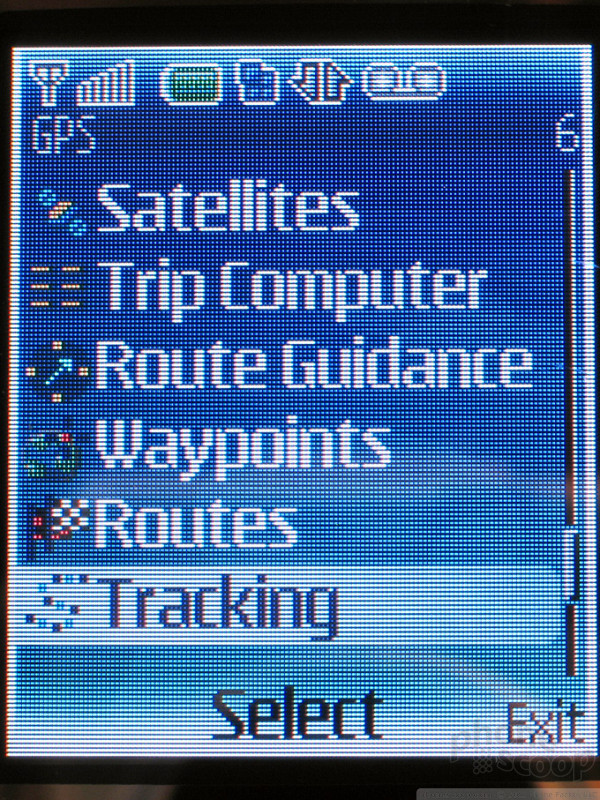




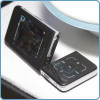 CES 2007 + iPhone
CES 2007 + iPhone
 Review: Jitterbug
Review: Jitterbug
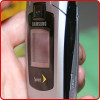 2006 Holiday Pre-Preview
2006 Holiday Pre-Preview
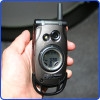 CTIA Fall 2006
CTIA Fall 2006
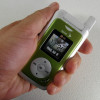 Review: LG Fusic
Review: LG Fusic
 Pantech Hero / PN-8300
Pantech Hero / PN-8300
 LG Fusic / LX-550
LG Fusic / LX-550
 Samsung SPH-A960
Samsung SPH-A960







